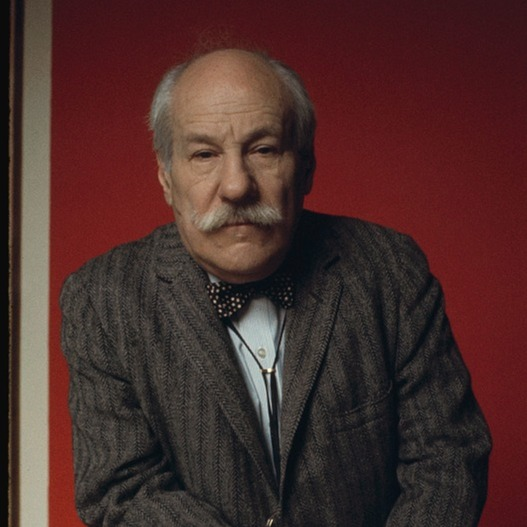
Barnett Newman
Underappreciated during his lifetime, Barnett Newman is now recognized as a pivotal figure in Abstract Expressionism. Rather than focusing solely on the non-representational meaning of shapes and colors, Newman's approach was more philosophical. He invited a viewer to experience his paintings both physically and intellectually, engaging with them on a profound level.
Biography of Barnett Newman
Barnett Newman was born in 1905 in New York. During high school, he began taking drawing lessons at the Art Students League, where he met Adolph Gottlieb, who introduced him to notable artists and gallery owners.
Newman pursued a philosophy education at City College of New York and later assisted his father in his clothing manufacturing business until it collapsed due to the 1929 stock market crash. After working as a substitute art teacher and contributing to a short-lived magazine about worker's rights, he married Annalee Greenhouse, a teacher. Following this, he decided to give up painting and delved into the study of ornithology and pre-Columbian art. Occasionally, he organized exhibitions and wrote catalogs and art reviews.
Collaborating with gallery owner Betty Parsons, who also represented his close friends Mark Rothko, Clyfford Still, and Jackson Pollock, Newman returned to painting in 1944 after a four-year hiatus. He was now inspired by Surrealism, which led him to destroy all his earlier work due to its figurative nature. This practice continued throughout his entire career, with Newman discarding any piece that did not meet his satisfaction.
A pivotal moment in Newman’s career occurred in 1948 when he introduced a pictorial element called a "zip." His first painting of this kind, "Onement I," featured a vertical stripe of color dividing the painted surface, which would become a trademark of his work.
The negative reception to Newman's new works exhibited at Betty Parsons Gallery, including violent reactions such as splashing and defacing of the paintings by the audience, led to his withdrawal from the gallery scene. Between 1951 and 1955, he focused on writing, and his pieces were not publicly shown. In 1957, the artist suffered a heart attack, and by the early 1960s, critics began to reconsider their opinions.
In 1959, Clement Greenberg organized a solo show for Barnett Newman at French & Company, marking Newman as an important figure in Abstract Expressionism. He expanded his work into sculpture and lithographs, which were included in significant museum exhibitions that solidified his position within the movement.
Despite this recognition, many struggled to understand Newman's art, leading to misinterpretations throughout his career. The artist became so resigned to this situation that he sometimes declined offers to exhibit alongside his contemporaries. Even after his major solo show at the Guggenheim in 1966, featuring his "Stations of the Cross" series, the reception did not notably improve. However, this did not deter him from creating some of his most significant works in the following years, including the series" Who’s Afraid of Red, Yellow and Blue" (1966-68) and the monumental sculpture "Broken Obelisk" (1963-69).
Among his peers from the New York School, Newman stood out as the most prolific writer, particularly at the outset of his artistic career. In his renowned essay "The Sublime is Now," Newman delved into the works of various 20th-century European artists, whom he believed had dismantled old standards of beauty.
In the late 1950s, a group of second-generation Abstract Expressionists began to imitate and develop Newman's style, seeking to eliminate all subjective elements, including visible brushstrokes. Without Newman's influence, Color Field Painting would likely have evolved differently. Despite his significant contributions, he was somewhat overshadowed by more famous figures like Jackson Pollock and Mark Rothko, leading to him being overlooked. In 1979, the Barnett Newman Foundation was established to promote and enhance the understanding of the importance of his work.
The artist passed away on July 4, 1970, due to a heart attack.
Barnett Newman's Art Style
As a member of various artistic groups, schools, and styles, Barnett Newman could be classified as an Abstract Expressionist. However, his art has also been associated with the Color Field movement, Formalism, and even proto-Minimalism. His extensive body of work encompassed paintings, drawings, prints, sculpture, and one architectural model. Unfortunately, his earliest works have not been preserved, as Newman chose to destroy all of his art pieces by 1944.
Newman's "zips" symbolized the space where the artist invited the viewer to enter and experience the totality of separateness and individuality, both personally and universally within the world, society, or universe. They embodied the physical body, contrasting with the color field that contained the raw energy of life. By repeatedly using this line, Newman contemplated his existence within the universe while also suggesting a passage beyond physical presence into the realm of his color field.
Initially, the color field was varied, but over time, the colors became pure and flat. The zips played a crucial role in defining the spatial structure, both dividing and uniting the composition. His paintings, purely abstract and left untitled, eventually acquired names related to Jewish themes such as Adam and Eve, Uriel, or Abraham.
Newman's series of black-and-white works, "The Stations of the Cross" (1958-66), served as a form of recovery after a heart attack. The subtitle "Lema sabachthani" or "Why have you forsaken me" referred to Jesus' last words on the cross and was also interpreted as a memorial to the victims of the Holocaust, aligning with Newman's intention to evoke the suffering of humanity throughout history. This distinctive series is characterized by its monochrome palette of black and white applied on raw canvases, with a focus on the use of the zip. Newman waited for spontaneous inspiration, taking eight years to complete the series.
By painting about tragedy, Newman believed that a reduced palette was the only way to express the depths of suffering. Despite the absence of color, he achieved a quality of color through form alone. As Newman himself expressed, a painter should strive to paint the impossible.
Years:
Born in 1905
Country:
United States of America, New York City